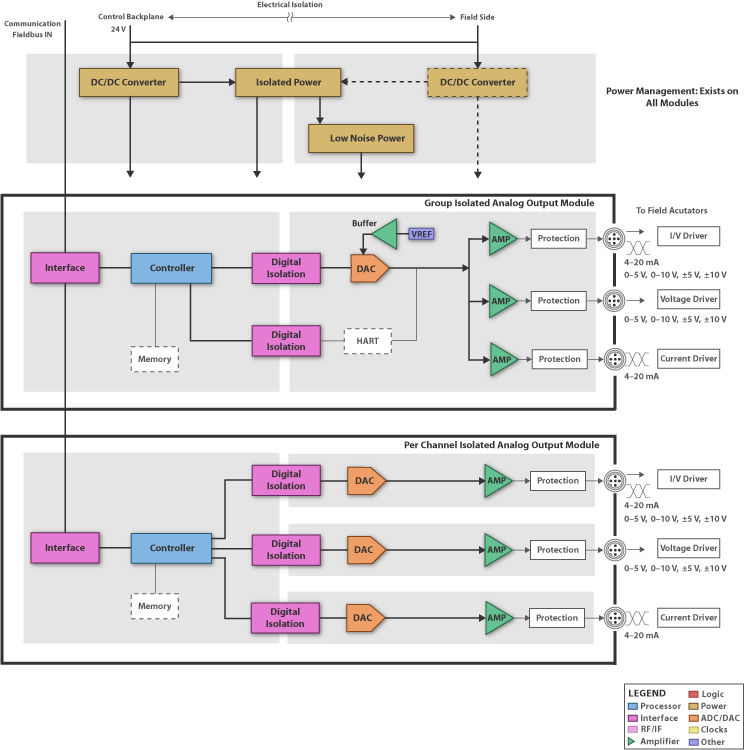
I/O modules are building blocks of industrial control systems used in end equipment such as PLC (Programmable Logic Controllers), PAC (Programmable Automation Controller) and DCS (Distributed Control Systems). Analog output modules are used to drive and control actuators and other machines and form part of an overall control system. Current-loop outputs typically range from 4-20mA while voltage outputs range from 0-5V, 0-10V, +/-5V and +/-10V.
Signal Chain
The linearity, settling time, response and accuracy is determined by the DAC used. Resistor string based DAC's are small, inexpensive and inherently monotonic. For higher resolution and for applications requiring higher linearity like open loop valve control, R-2R DAC's are a good choice. Finally for achieving the fastest settling times and speeds, R-2R multiplying DAC's should be used. Selecting the right reference and pairing it with the right buffer can impact system performance. Considerations for references include initial accuracy, temperature drift and source/sink current capability.
The output amplifier must be picked based on speed, output voltage level and power. TI's XTR family of industrial drivers is a good choice to implement 4-20 mA current loops. Some products allow the designer to make the output programmable to be either a voltage or current. Newer products integrated the DAC and XTR together to minimize board space and optimize power.
Processor
Development platforms and software tools in addition to support which quickens time to market are highly desired. Connectivity options ranging from Ethernet ports to UARTs to simple SPI ports are desired. Ethernet enables integration of field devices to the corporate enterprise network. Most industrial control applications need simple low cost PLC's with lots of digital I/O and integrated functions. These include fault diagnostics, watchdog timers, low power, multiple SPI ports, UART's, integrated analog peripherals like ADCs and PWM outputs which perform similar functions to DACs. MCU's (Micro Controller Units) are a good choice for these applications. For applications which push capabilities and need higher loop rates along with advanced control algorithms to handle multiple functional domains like logic, PID control and motion, higher performance MPU's (Micro processing Units) are needed.
Industrial applications need to support a multitude of communication options. Many of TI's processors include a Real time Processing Unit (PRU) to support a truly programmable approach for these communication standards. In addition, the ARM architecture offers the performance and low power needed for mission critical functions.
Interface
There are a number of field bus options – both serial (RS-485, DeviceNet, Profibus, CAN etc.) and Ethernet based. Extended cable reach and diagnostics to debug wire breaks provides system designers significant value. Integrated digital isolation on the interface transceivers is highly desirable to reduce board space. In addition the interface between the DAC and the controller can be digitally isolated either by using opto-couplers or TI isolators built with capacitive technology.
Microcontroller
The Hercules™ Safety MCUs offer an ARM Cortex-R4F based solution and are certified suitable for use in systems that need to achieve IEC61508 SIL-3 safety levels. These MCUs also offer integrated floating point, 12 bit ADCs, motor-control-specific PWMs and encoder inputs via its flexible HET Timer co-processor. Hercules Safety MCUs can also be used to implement scalar and vector-control techniques and support a range of performance requirements.
Power
To protect against transients and ground loops, the field side which interfaces to sensors is electrically isolated from the control side. This is done on a per channel basis or by isolating groups of channels from each other and from the control side. The design can be customized for performance and cost by using a DC-DC converter and discrete components or pre-built isolated DC-DC converter modules can be used. Other considerations include high efficiency and integration along with smaller packages. Picking a DC-DC converter with a large input range will protect again supply transients. Finally, using LDO's with good PSRR (Power Supply rejection Ratio) to supply the precision analog circuitry will reduce the power supply ripple and preserve system accuracy and resolution.
Download Full Block Diagram Below
Advertisement

Learn more about Texas Instruments





